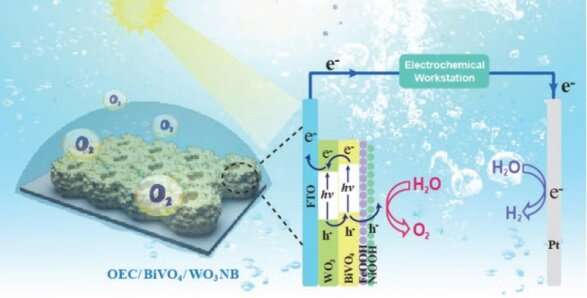Improving performance for efficient photoelectrochemical water splitting

Photoelectrochemical (PEC) water splitting is a promising green technique for renewable hydrogen production. To construct a practical PEC system, it is of great significance to develop efficient photoanodes. BiVO4 has been identified as the most promising photoanode material because of its narrow band gap and favorable band positions for hydrogen and oxygen evolution. Nevertheless, BiVO4 has limitations of low carrier mobility (4×10−2 cm2·V−1·s−1) and short hole diffusion length (<100 nm) as a photoanode, resulting to an unsatisfactory photocurrent density (<1 mA·cm−2 at 1.23V vs. RHE in neutral medium under AM 1.5G illumination). Therefore, it is necessary to explore a series of methods to improve the PEC performance of BiVO4.
It has been proposed and investigated that inserting a new layer between BiVO4 and fluorine-doped tin oxide (FTO) can improve the carrier separation efficiency. Among them, BiVO4/WO3 is a proven type II heterojunction. Surface and deposition of an oxygen evolution co-catalyst (OEC) layer can enhance the water oxidation kinetics. But most WO3 arrays on FTO electrodes exhibit small array gaps (< 60 nm), which are not conducive to uniform loading of BiVO4 nanoparticles with the sizes larger than 80 nm. Furthermore, the upper layer of BiVO4 is coated on the bottom WO3 layer to form a bilayer heterojunction, which exhibits a small contact area and inevitable charge recombination in the bulk and boundary of BiVO4 particles.
Recently, a research team led by Prof. Junwang Tang from University College London, U.K. and Hai-Ying Jiang from Northwest University, China fabricated WO3 nanobowl arrays based on monolayer colloidal crystals (MCCs) to construct a highly matched BiVO4/WO3 heterojunction with BiVO4. In this novel design, the small-sized BiVO4 nanoparticles (<90 nm) are perfectly deposited on the bottom layer of the WO3 nanobowl with a large inner diameter of 920 nm. The size of BiVO4 is smaller than its hole diffusion length (~100 nm), ensuring that holes are efficiently transferred to its surface. Meanwhile, a highly ordered monolayer WO3NB array was chosen to minimize WO3 defects at grain boundaries, reducing the interfacial resistance with FTO and increase the contact area with BiVO4 nanoparticles. In addition, the highly matched BiVO4/WO3 interface can also enhance the charge separation of BiVO4, which plays an important role in the PEC process. To enhance the water oxidation kinetics, the authors further loaded an OEC layer on the BiVO4/WO3NB heterojunction photoanode, which produced about 5 times higher photocurrent and IPCE than pristine BiVO4 under one sunlight condition.
The results were published in the Chinese Journal of Catalysis.
More information: Wen Zhang et al, Conformal BiVO4/WO3 nanobowl array photoanode for efficient photoelectrochemical water splitting, Chinese Journal of Catalysis (2022). DOI: 10.1016/S1872-2067(21)63927-X
Provided by Chinese Academy of Sciences


















